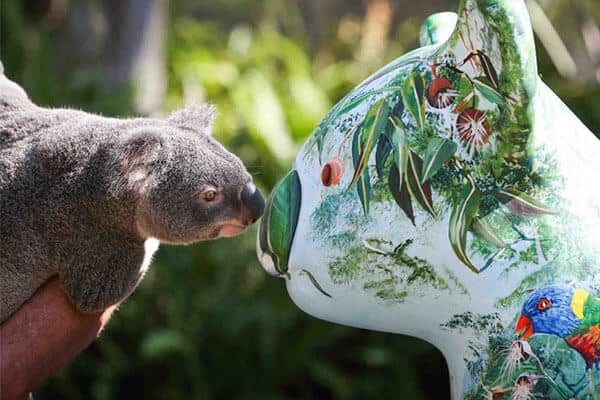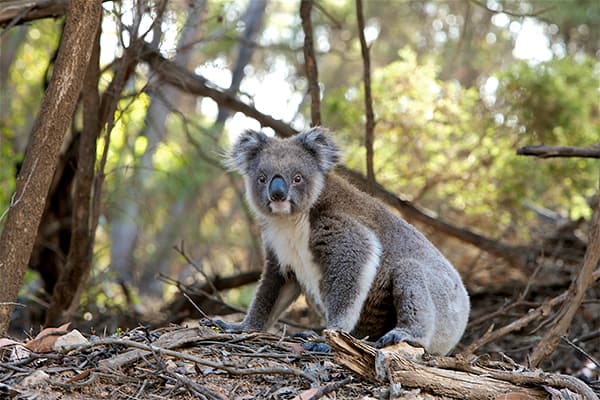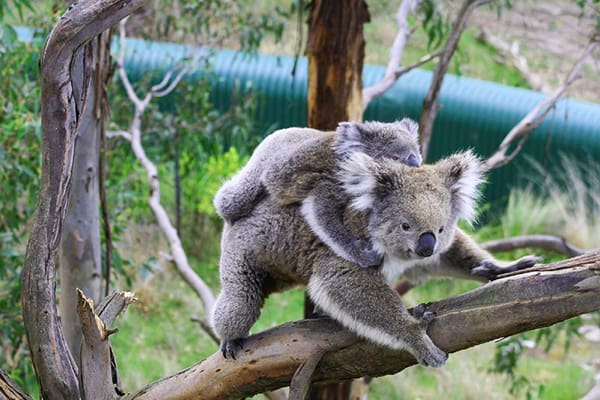Here at The Westport Club we love nothing more than sharing exciting upcoming events with our members and readers, especially when the focus is on important environmental issues such as koala preservation. It is with great anticipation that we present a new event on the Port Macquarie calendar: The Hello Koalas Festival
Building on the success of the Hello Koalas Sculpture Trail, now a high profile permanent tourist attraction for the Port Macquarie-Hastings region, the Hello Koalas Festival will offer an exciting program of creative events and activities for all ages over the June long weekend. Of course, The Westport Club will be waiting to provide a place to relax and unwind at the end of a long day enjoying the Festival activities. Read on to find out what’s in store!

The Hello Koalas story
The Hello Koalas Sculpture Trail is the Port Macquarie-Hastings region’s most popular tourist attraction. Created in 2012, it has attracted widespread support from local businesses as well as government and community organisations, such as the Port Macquarie Koala Hospital. The Sculpture Trail features more than 50 one metre high fibreglass koala sculptures, all individually designed and hand painted by local artists, spread across the Port Macquarie-Hastings landscape from the mountains to the sea.
According to the Hello Koalas website, “Hello Koalas is a bold, ambitious and imaginative sculpture project, which celebrates one of Australia’s iconic animals – the Koala. Above all, it is designed to generate a sense of fun and surprise for everyone who comes across one of the creatively decorated koalas resting in parkland, lazing by the river, waiting outside the shops, or playing with children.” The Hello Koalas sculptures can be found anywhere and everywhere!
The Hello Koalas project was inspired by the highly successful Larkin With Toads public art project in Hull, UK and was conceived by Arts and Health Australia.
The Hello Koalas Festival
Held from June 1 to June 11 2017, the inaugural Hello Koalas Festival invites everyone to enjoy a range of activities. During these, participants will learn about the importance of caring for the koala within the fragile Port Macquarie-Hastings ecosystem. There will be entertainment for all age groups, and the opportunity to discover the plight of our poor koalas.
Festival highlights include the Port Macquarie Koala Hospital’s Second National Koala Conference at Rydges, running from June 2 to June 4. Conference attendees will have the opportunity to hear from several key speakers including Michael Roache, Principal Project Officer for Threatened Species within the Office of Environment and Heritage. According to Margret Meagher, Hello Koalas Project Director: “[Michael] has an in-depth understanding of threatened species recovery and terrestrial conservation programs…[he] is leading the developing NSW Government koala strategy and was in Port Macquarie a couple of months ago for the community consultations.”
You will have the chance to paint your very own mini Hello Koalas sculpture, and to dress up in your best party attire to attend the Hello Koalas Picnic and Festival Parade. Don’t forget to bring along your favourite koala toy! There will be plenty of games to play and prizes to win. Also in store is a ‘Koalas in Kolour’ exhibition at the Port Macquarie Museum, and the launch of a new environmental experience on the boardwalk at Sea Acres, encompassing six brand new Hello Koalas sculptures. You can follow the Hello Koalas Festival Facebook page for updates.

Koala preservation
The Port Macquarie-Hastings region is part of a unique ecosystem of native flora and fauna, and home to the largest koala population on the east coast of Australia. The koala is a very important member of this ecosystem, not to mention one of the cutest! Can you imagine an Australia without our beloved koala bear? (Okay, the koala isn’t really a bear, but more on this later…)
The koala species is on the decline and it is vital that we maintain our preservation efforts to prevent the koala from becoming classified as endangered. The koala is now listed as a ‘Vulnerable Species’ on the International Union for Conservation of Nature Red List of Threatened Species. Extensive development and habitat clearing for urban expansion has seen a noticeable drop in breeding koalas around Port Macquarie in recent years. Current information suggests we may in fact be reaching a pinnacle moment: failure to act now to manage our iconic koala population will result in devastating, irreversible decline. The negative consequences of human intervention in the koala’s natural habitat means that sustaining the koala population will rely on human action. Above all, restrictions need to be placed on housing development in highly koala-populated areas.
In 2016, the NSW Government announced plans to spend $10 million over five years to protect the state’s deteriorating koala population following the release of NSW chief scientist Mary O’Kane’s report into the decline of koala populations across the state. Education and awareness of the koala’s plight is first and foremost when it comes to implementing practical solutions for the regeneration and conservation of the koala population. Consider one example: koala food sources. Even though there are over 700 species of native Australian eucalypts, in each region koalas only eat around 10 types as their main food source. In the Port-Macquarie Hastings region koala food trees include Tallowwood, Flooded, Rose and Cabbage Gums, and Red and Swamp Mahoganies. Protecting the koala implies preserving the native flora on which they thrive.

The Port Macquarie Koala Hospital
One of the organisations working to prevent the decline of one of the largest coastal koala populations in the country is the Port Macquarie Koala Hospital. Established in 1973, the Koala Hospital is recognised world-wide as a peak body which participates in forums for debate on significant policy issues, and plays a significant leadership role in research. The work of the Koala Hospital is supervised and carried out by paid staff alongside over 200 dedicated volunteers. Tasks include coordination and planning, fundraising, yard duties, rescues, home care, tree planting and maintenance.
The Koala Hospital is also one of the area’s prime tourist attractions and places huge emphasis on education. There is a training facility for schools and groups, guided ‘Walk and Talk’ tours at 3pm daily, displays showing koala habitat and issues that affect koalas as well as chronicles of patients in care. The primary reasons for which a koala would be submitted is injury due to bushfire, dog attacks and collisions with vehicles. Cheyne Flanagan, clinical director, says koala admissions to the facility have decreased by more than 60 annually over the past few years, a sign that one of the only remaining stable koala populations in Australia is in serious trouble.
Koala fun facts
Koalas are unique to Australia and cannot live in any other part of the world. The koala is a marsupial mammal, related to the kangaroo and the wombat, and not the bear as many people believe. Today, there are somewhere between 2,000 to 8,000 koalas in the wild – the Australian koala population has dropped by over 90% in the past decade due to the destruction of its natural habitat. In fact, 80% of koala habitat has already disappeared.
The koala eats one type of food only, eucalyptus leaves, and will consume up to one kilogram of food a day. Humans are the koala’s most dangerous enemy although occasionally koalas are preyed upon by goannas, dingos, eagles and owls. The koala lifespan is around 12-15 years and female koalas usually have one joey per year, increasing to every two years as they get older. The koala joey leaves its mother’s pouch for the first time at about 5.5 months. It leaves the pouch permanently at 8 months, after which time it will cling to its mother’s back or stomach, sticking its head into her pouch to feed.
Koalas have specially adapted to their environment by developing extra thick fur, especially on the neck and shoulders, which helps protect the species from weather conditions. Their body shape provides stability while they sit in trees and their opposable thumbs and toes with rough pads allow for tight grip when climbing. Koalas have large noses with sensitive hairs enabling them to detect differences in smell between varying eucalyptus leaves. They have cheek pouches in which they can store food not yet chewed while moving to a safer location. The koala cools itself by licking its arms and stretching its body to rest in the trees.
Koalas are mostly nocturnal, which means they are awake at night and asleep during the day. They often sleep for up to 18-20 hours because it requires a lot of energy to digest the toxic, fibrous, low-nutrition diet they consume. Koalas communicate with each other by using a range of noises. The most recognisable (and loud) is the famous koala bellow which sounds like a heavy snore and then a belch.

Hello Koalas Festival recovery
You’re definitely going to work up an appetite trekking around to see all those koala sculptures. Join us at The Westport Club for a delicious dinner after exploring the Hello Koalas Festival offerings. Enjoy your favourite beverage while telling us all about your favourite festival activities – we’d love to hear what you’ve learnt about koala preservation. The Westport Club offers one of the best views across the stunning Hastings River, so if you’re visiting the area, a meal at Aqua is not to be missed.

